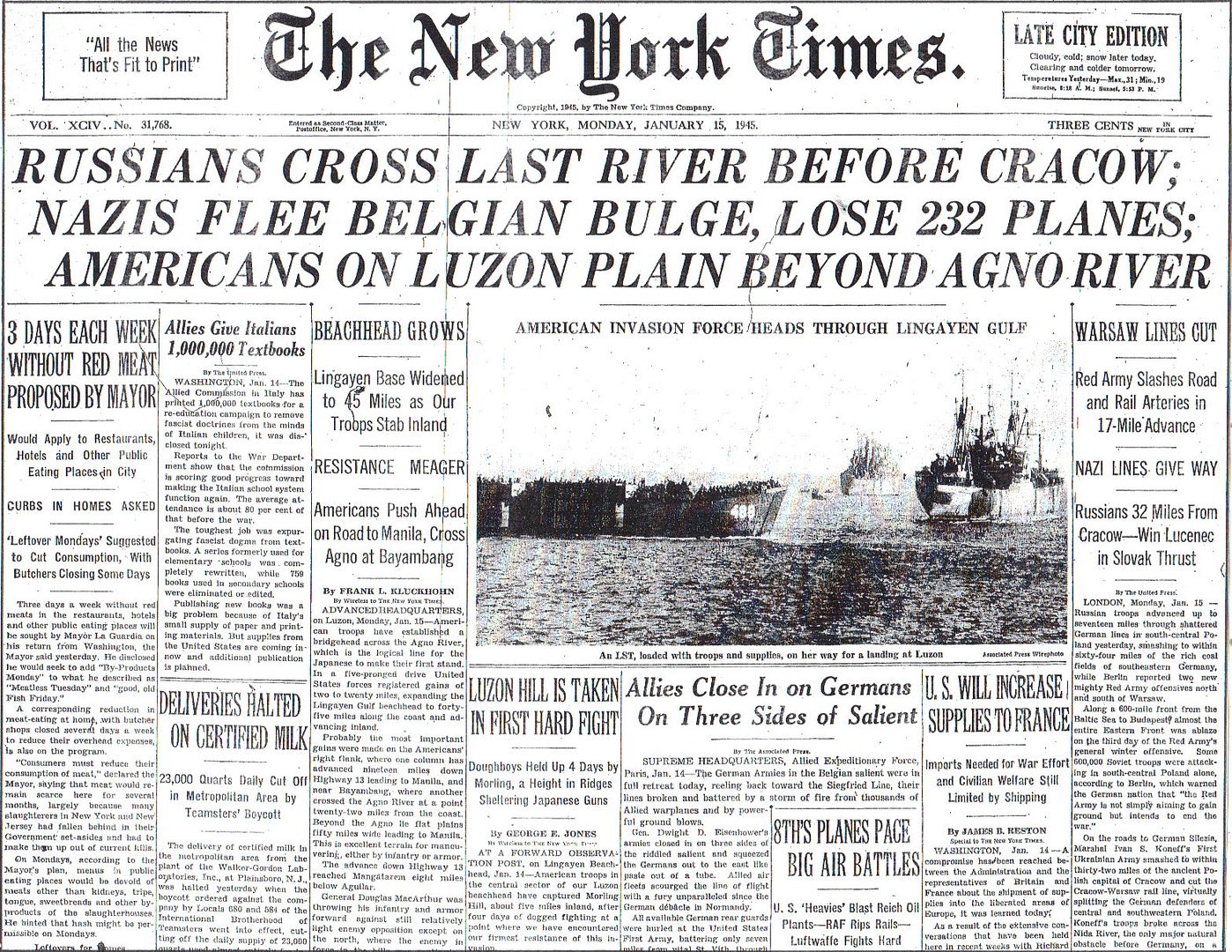
Posted on 01/15/2015 4:19:21 AM PST by Homer_J_Simpson

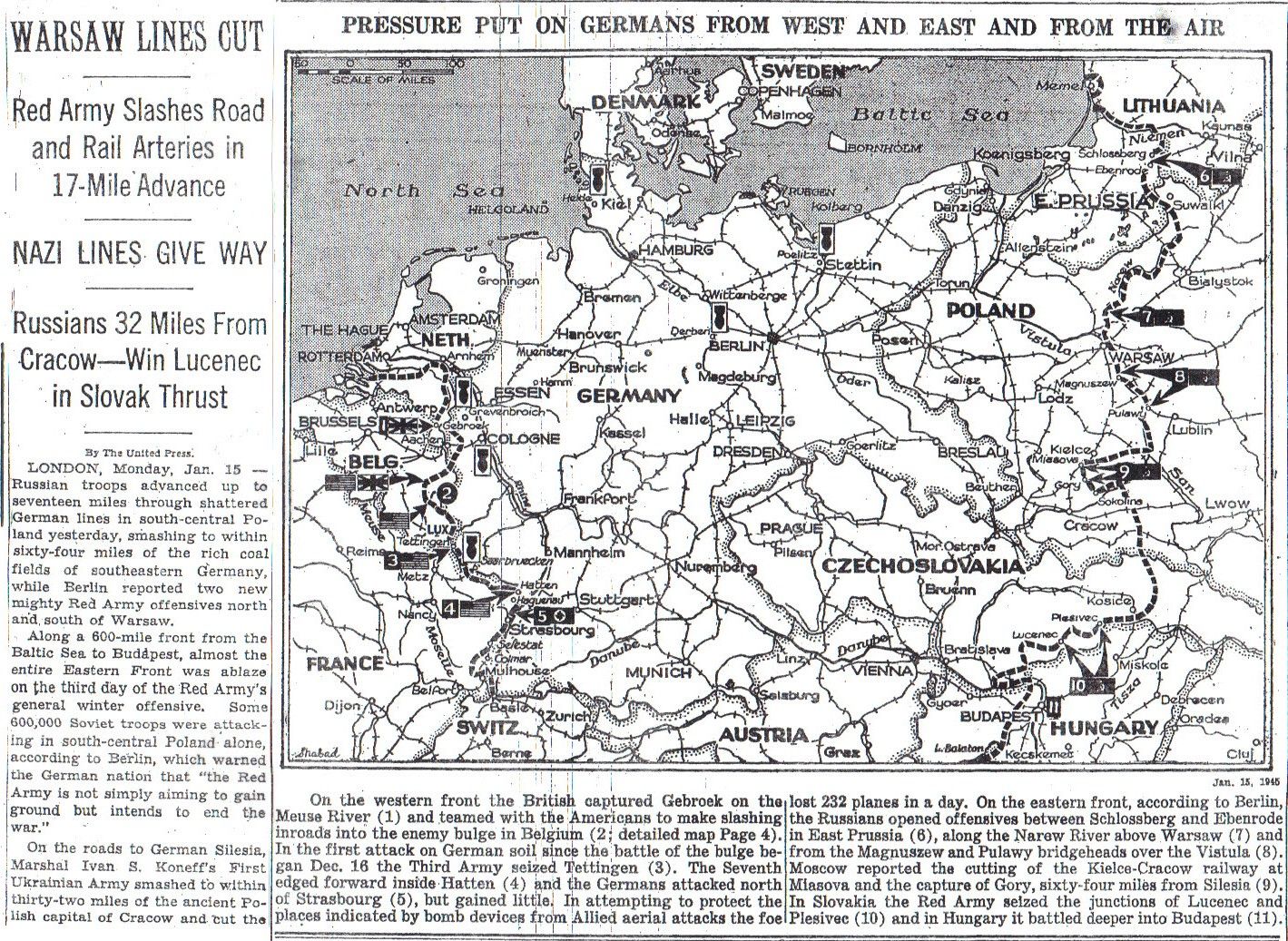

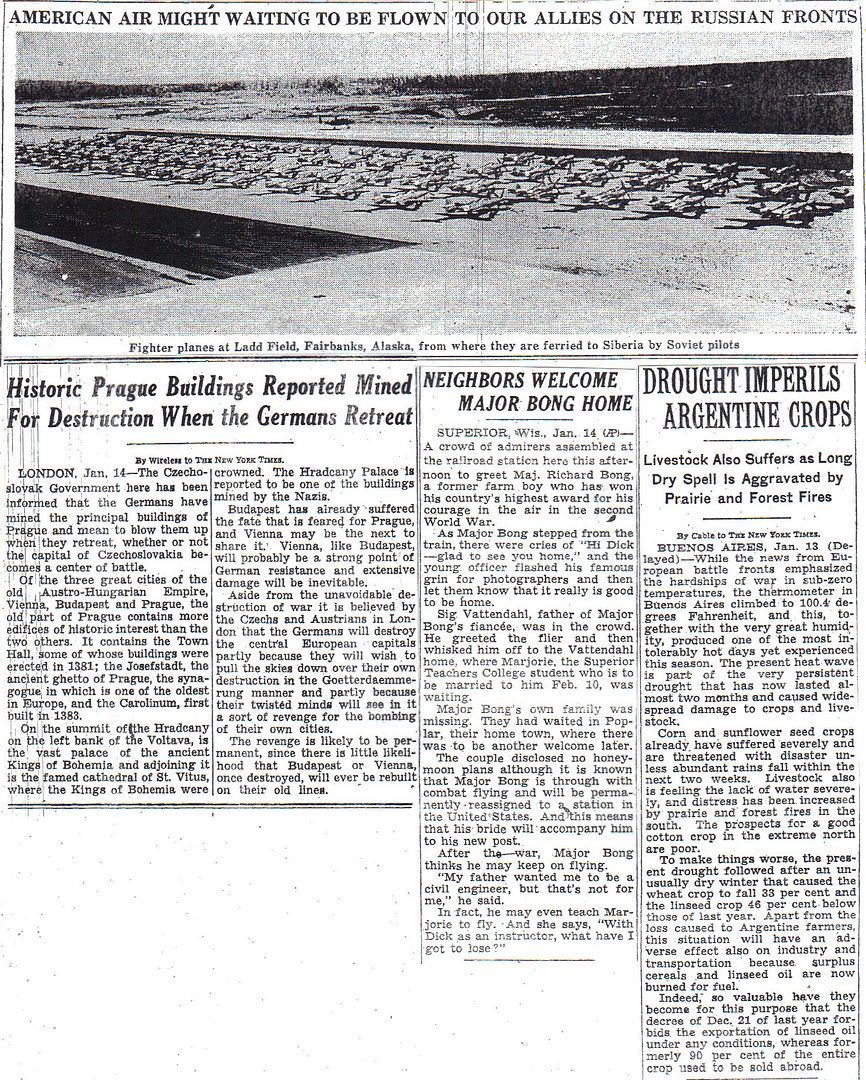
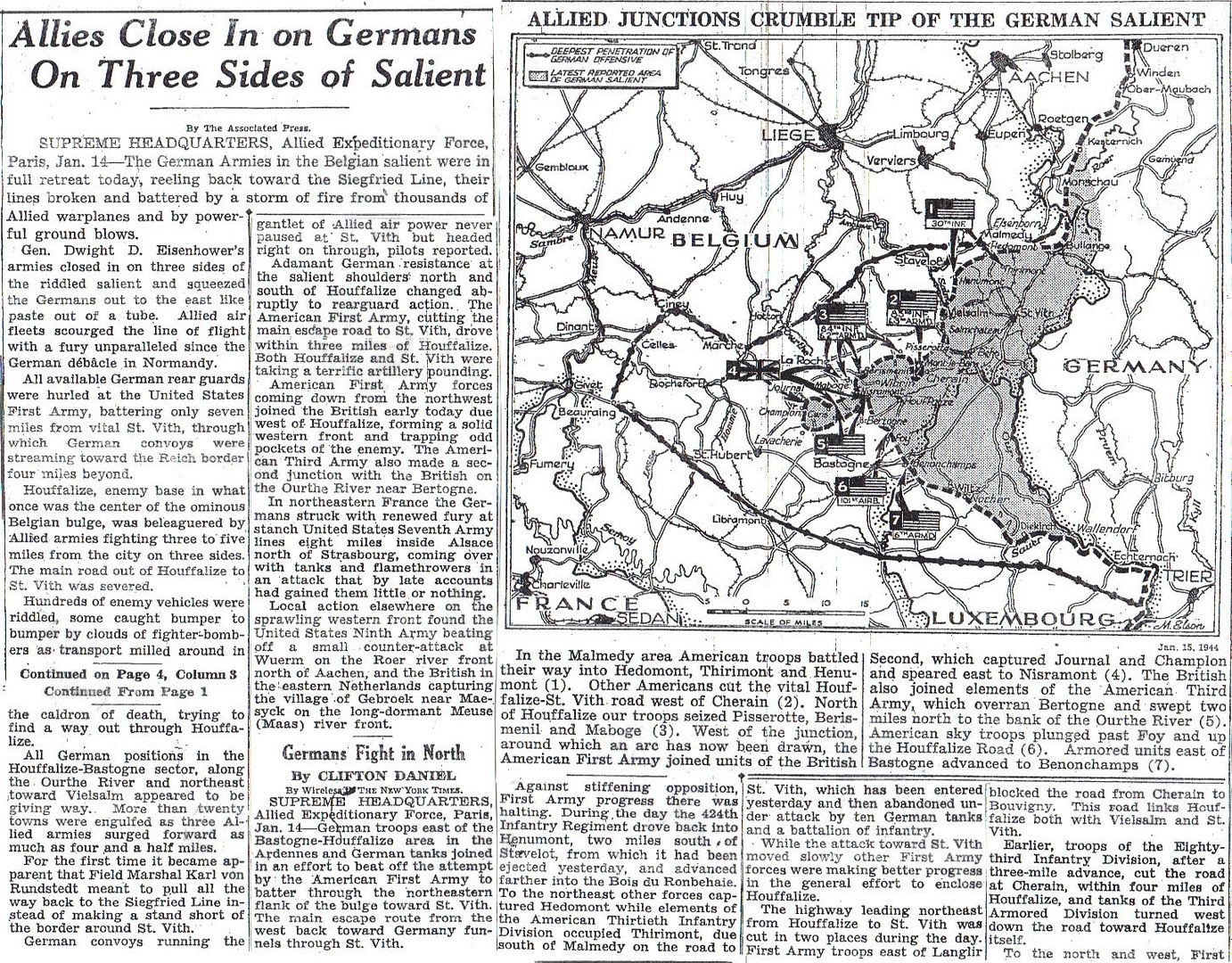
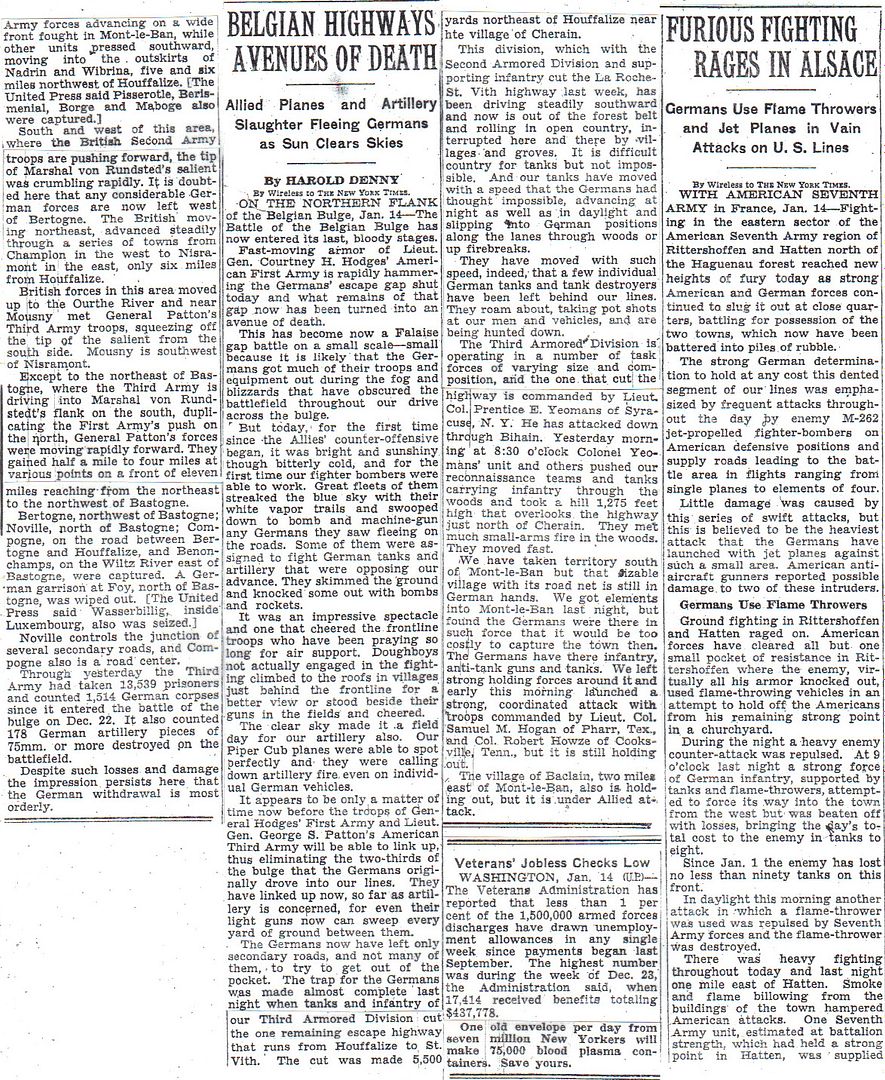
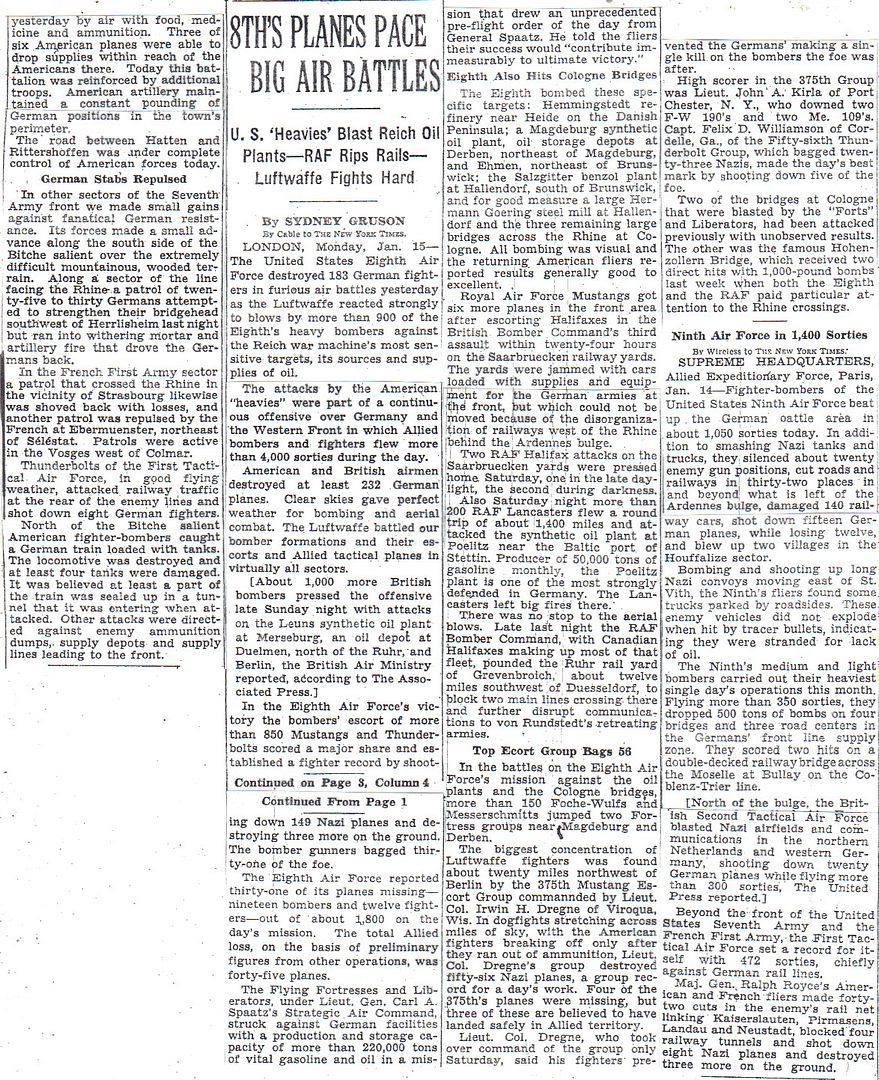
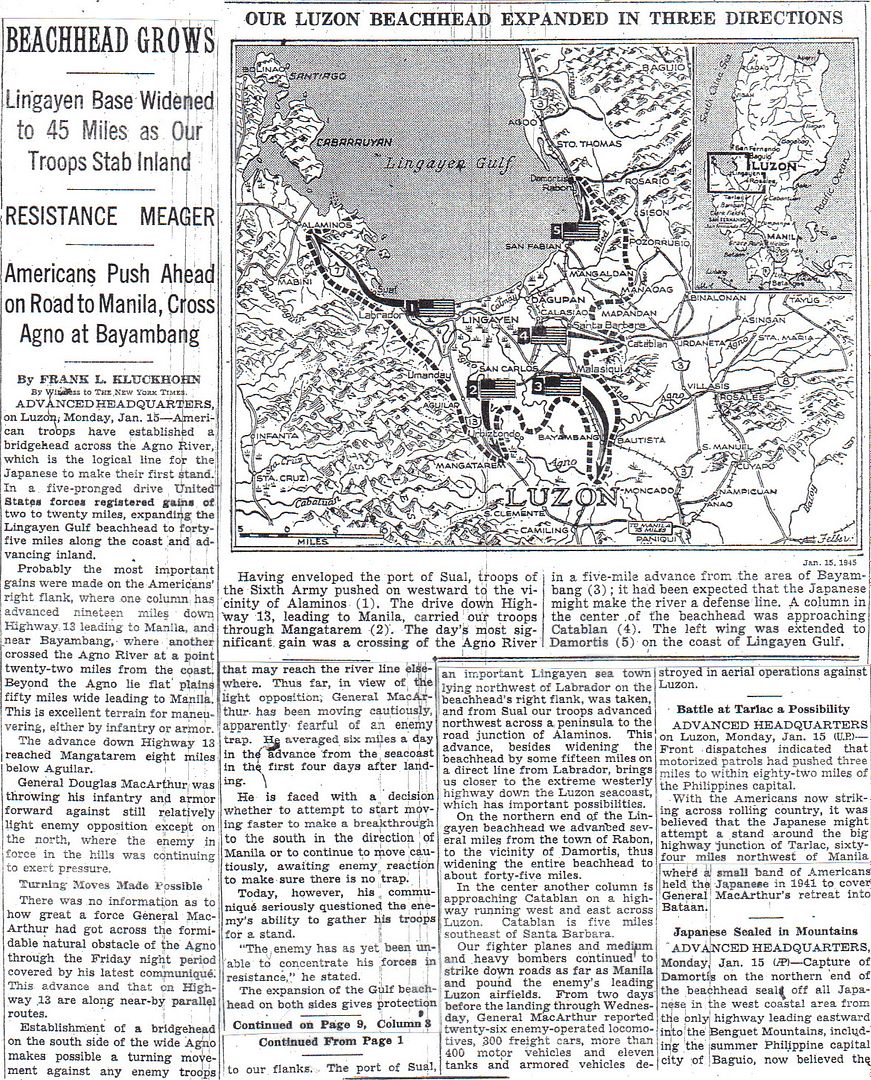

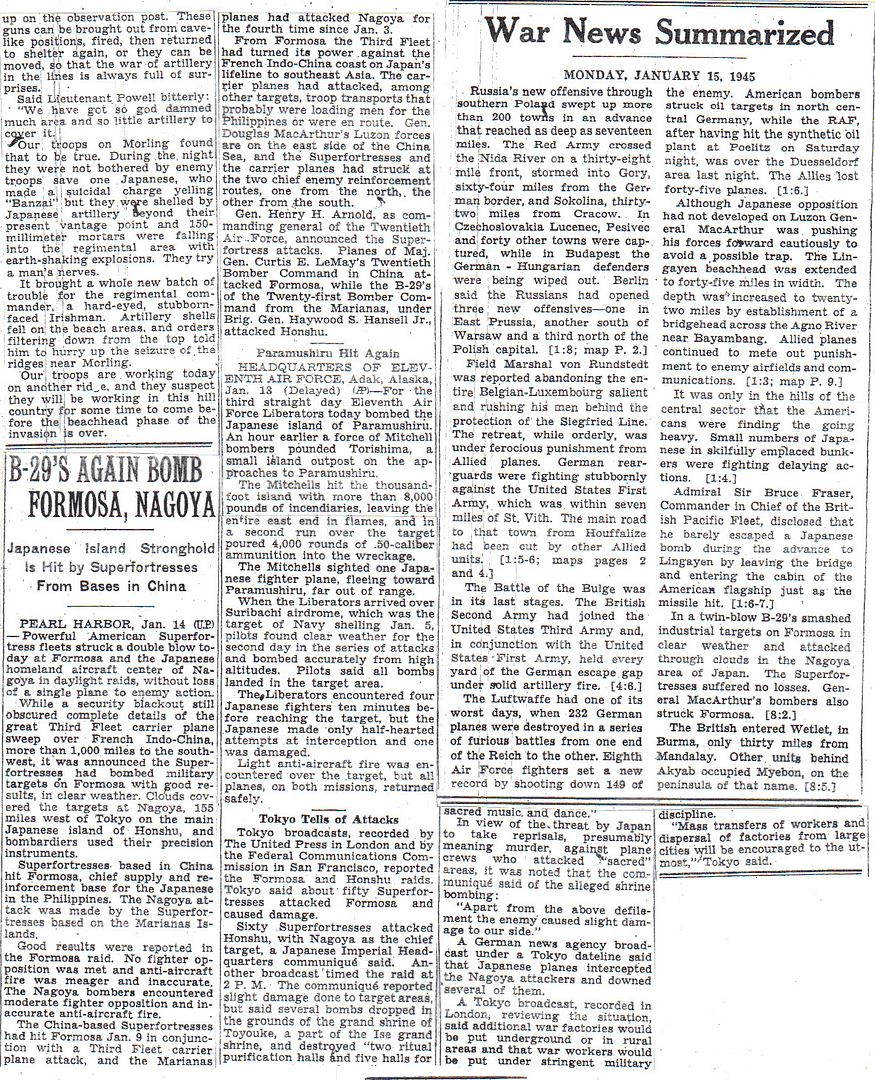
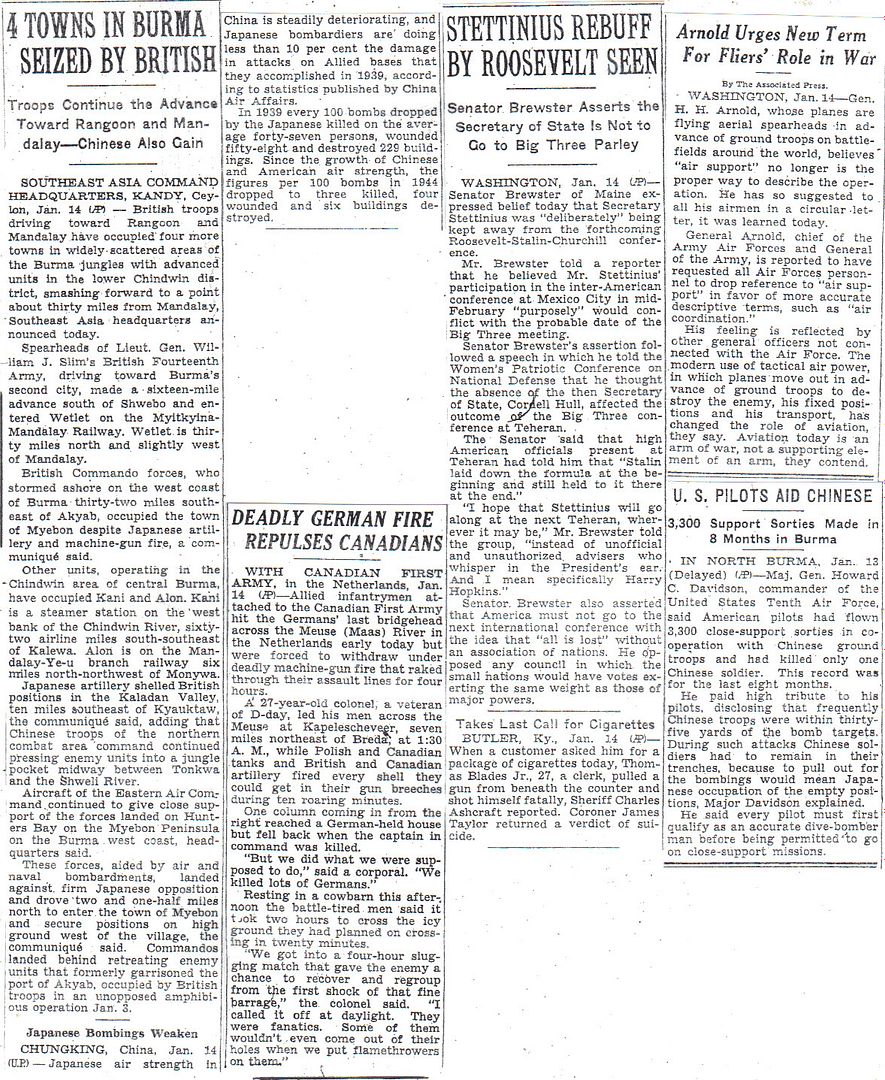
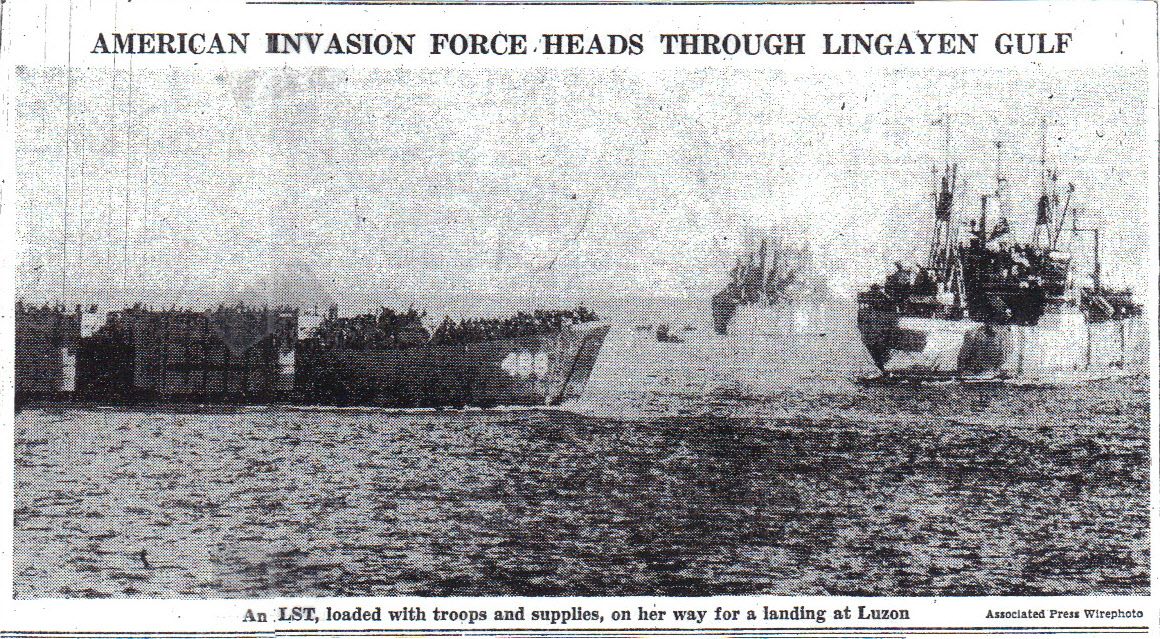


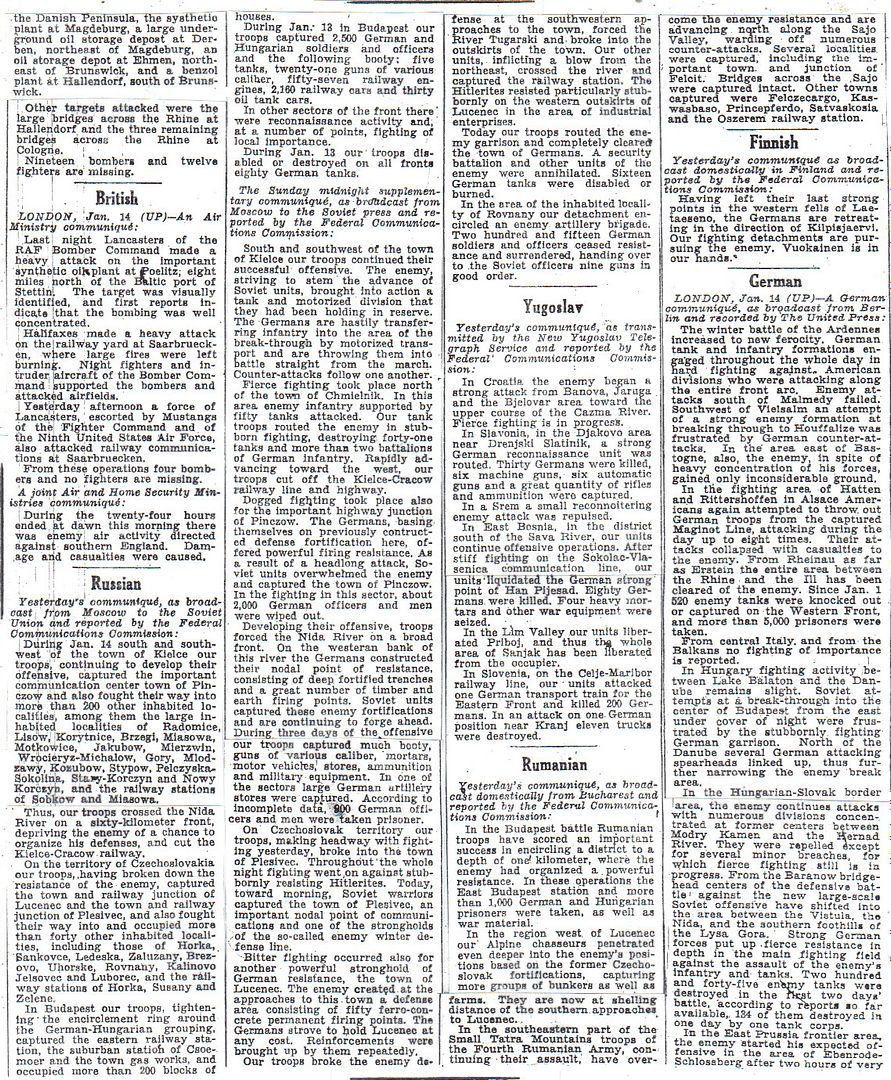
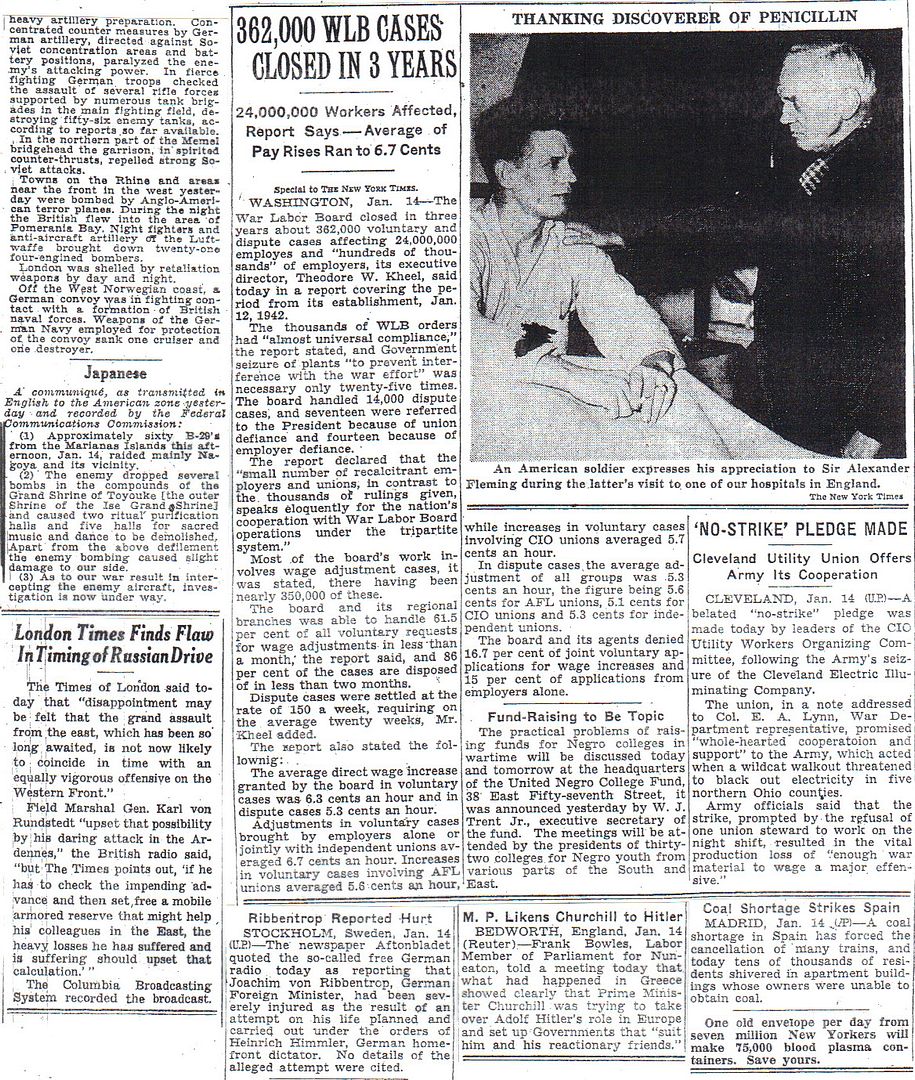
http://www.etherit.co.uk/month/0/15.htm
January 15th, 1945 (MONDAY)
UNITED KINGDOM: U-1172 (Kapitanleutnant Hartmut Graf von Matuschka) claimed two torpedo attacks. They are believed to have been against the British escort carrier HMS Thane and the Norwegian tanker Spinanger which were both hit by torpedoes and damaged whilst at anchor in the Firth of Clyde at 55 10N, 04 30W. There are 10 casualties on THANE. Thane was surveyed but not considered worth repairing and was laid up in the Gareloch. (Alex Gordon)(108)
Aircraft carrier HMS Vengeance commissioned.
WESTERN EUROPE: The USAAF Ninth Air Force’s XIX Tactical Air Command escorts the B-26 Marauders on a raid in Germany, flies armed reconnaissance and patrols, and supports the U.S. III and VIII Corps in the Houffalize, Belgium-Bastogne, Belgium-Wiltz, Luxembourg areas.
During the night of 15/16 January, the USAAF Eighth Air Force flies Mission 795: two B-17 Flying Fortresses and seven B-24 Liberators drop leaflet on the Netherlands and Germany without loss.
BELGIUM: On a cold, cloudy day the 101st Airborne Division resumed its drive to the north and to the northeast. On the west of the Bastogne - Houffalize highway the 1st and 2nd battalions of the 506th Parachute Infantry attacked at 1030. (The guys slept in that morning.) The 1st Battalion struck out east of Fazone Woods and advanced over almost one mile of open fields to take the high ground north of Cobru. The 2nd Battalion attacked north and seized Noville from which the 1st Battalion and Team Desorby had withdrawn almost one month before. Observers from the 321st Glider Field who had been with the 1st battalion then were with the 2nd Battalion this day. A perimeter defence was set by 1145. It was a slow day for the 506th. (Jay Stone)
Near Arloncourt, Corporal Arthur O. Beyer, U.S. Army, Company C, 603d Tank Destroyer Battalion, displays conspicuous gallantry in action, when his platoon was held up by anti-tank, machine gun and rifle fire from enemy troops dug in along a ridge about 200 yards to the front. Noting a machinegun position in this defence line, he fired upon it with his 76-mm. gun killing 1 man and silencing the weapon. He dismounted from his vehicle and, under direct enemy observation, crossed open ground to capture the 2 remaining members of the crew. Another machinegun, about 250 yards to the left, continued to fire on him. Through withering fire, he advanced on the position. Throwing a grenade into the emplacement, he killed 1 crewmember and again captured the 2 survivors. He was subjected to concentrated small-arms fire but, with great bravery, he worked his way a quarter mile along the ridge, attacking hostile soldiers in their foxholes with his carbine and grenades. When he had completed his self-imposed mission against powerful German forces, he had destroyed 2 machinegun positions, killed 8 of the enemy and captured 18 prisoners, including 2 bazooka teams. Cpl. Beyer’s intrepid action and unflinching determination to close with and destroy the enemy eliminated the German defence line and enabled his task force to gain its objective. (MOH)(Drew Philip Halévy)
On the U.S. First Army’s VII Corps right, the 2d Armored Division clears Achouffe, Mont, and Tavernaux and sends patrols to the Ourthe River and into Houffalize, which has been vacated by the Germans. The 3d Armored Division attacks with Combat Command R toward Vaux and Brisy, taking Vaux, and with Combat Command B toward Cherain and Sterpigny. Elements of Combat Command A are committed as reinforcements. A battalion of the 83d Infantry Division attacks Bovigny but is unable to take it. In the XVIII Corps (Airborne) area, the 75th Infantry Division attacks across the Saim River before dawn and seizes Salmch teau and Bech. The 106th Infantry Division consolidates and clears Ennal. The 30th Infantry Division takes Beaumont, Francheville, Houvegnez, and Pont; improves positions south of Ligneuville; and clears the northern part of Thirimont. The V Corps opens an offensive to clear heights between Buellingen and Ambleve and to protect the left flank of the XVIII Corps.
The 1st Infantry Division, reinforced by Regimental Combat Team 23 of the 2d Infantry Division, attacks southeast with the 23d Infantry Regiment on the right, the 16th Infantry Regiment in the center, and the 18th Infantry Regiment on the left; gains Steinbach, the neighboring village of Remonval, and the northern half of Faymonville, but is held up south of Butgenbach by heavy fire.
In the U.S. Third Army’s VIII Corps area, Combat Command A of the 11th Armored Division takes Cornpogne and Rastadt and reaches Vellereux; falls back west of Vellereux under a counterattack in the Rau de Vaux defile. Combat Command B bypasses Neville and clears the woods to the east. On a cold, cloudy day the 101st Airborne Division resumes its drive to the north and northeast. On the west of the Bastogne-Houffalize highway the 1st and 2nd Battalions, 506th Parachute Infantry Regiment, attack at 1030 hours. (The guys slept in that morning.) The 1st Battalion strikes out east of Fazone Woods and advances over almost 1 mile (1,6 kilometers) of open fields to take the high ground north of Cobru. The 2nd Battalion attacks north and seizes Noville from which the 1st Battalion and Team Desorby had withdrawn almost one month before. Observers from the 321st Glider Field Artillery Battalion, who had been with the 1st Battalion then, are with the 2nd Battalion today. A perimeter defense was set by 1145 hours. It is a slow day for the 506th. In the III Corps area, the 6th Armored Division, employing the 320th Infantry Regiment of the 35th Infantry Division, overcomes house- to-house resistance in Oubourcy; Combat Command B takes Arloncourt; Combat Command A clears the heights southwest of Longvilly. The 357th Infantry Regiment battles strongpoints in and around the railroad tunnels along the Wiltz River valley while the 359th Infantry Regiment starts to Wardin. (Jay Stone and Jack McKillop)
NETHERLANDS: In the British Second Army’s XII Corps area, in preparation for Operation BLACKCOCK, the operation to clear the German salient between the Meuse and Roer-Wurm Rivers from Roermond southward, elements of the 7th Armoured Division seizes Bakenhoven about 1 mile (1,6 kilometers) northwest of Susteren as the line of departure for the main attack by the division on the left flank of corps.
FRANCE: The 6th Army Group issues preliminary instructions for an attack against the Colmar Pocket by the French First Army, which for some time has been engaged in the aggressive defense of the Vosges Mountains.
In the U.S. Seventh Army’s VI Corps area, local actions occur around the Bitche salient perimeter. The 14th Armored Division continues their fight for Rittershoffen and Hatten.
LUXEMBOURG: In the U.S. Third Army’s III Corps area, the 358th Infantry Regiment, 90th Infantry Division, meets unexpectedly strong resistance as it resumes their northeastern attack; the 1st Battalion makes a forced march into the 6th Armored Division sector to attack Niederwampach from the Benonchamps, Belgium area and gains the town after artillery barrage by 14 field artillery battalions.
GERMANY: Hitler leaves the western Führer headquarters ‘Eages Nest’ (Führerhauptquartier ‘Adlerhorst’), located in the Taunus mountains in a large military reservation encompassing remote portions of the towns of Langenhein-Ziegenberg, Wiesental and Kransberg (all near Bad Nauheim), on board his ‘Führersonderzug’ (special train) bound for Berlin. (Russell Folsom)
In the U.S. Third Army’s XX Corps’ 94th Infantry Division zone, the 1st Battalion of the 376th Infantry Regiment holds Tettingen and Butzdorf against counterattack while the 3d Battalion takes Nennig, Wies, and Berg.
The USAAF Eighth Air Force flies Mission 794: 640 bombers and 782 fighters are dispatched to hit marshalling yards in Germany; they claim 14-0-19 Luftwaffe aircraft; two fighters are lost. The targets are (numbers in parenthesis indicate number of aircraft bombing and number lost, e.g., 97-1):
- Marshalling yards: Augsburg (286-0), Freiburg (107-0), Ingolstadt (110-0), Reutlingen (75-0) and Tubingen (7-0).
- Railroads: Freudenstadt (1-0) and Kilchberg (19-0).
- Targets of opportunity: 13 aircraft.
Sixteen USAAF Ninth Air Force B-26 Marauders hit the Simmern bridge to help thwart movement in the Trier area.
During the day, RAF Bomber Command dispatches bombers to attack benzine plants at two locations without loss:
- 82 Lancasters are sent to attack the Langendeer plant at Bochum; 61 bomb the target. The bombing appears to be excellent.
- 63 Lnacasters are sent to the Forzetzung plant at Rechlinghausen; 61 bomb the targets.
AUSTRIA: USAAF Fifteenth Air Force: B-17 Flying Fortresses and B-24 Liberators, escorted by P-38 Lightnings and P-51 Mustangs, bomb two marshalling yards (M/Ys) in Vienna: 200 hit the Matzleinsdorf M/Y with the loss of eight aircraft and 188 bomb the Florisdorf M/Y with the loss of six aircraft.
POLAND: The Soviet Army offensive is extended southward as the Fourth Ukrainian Front begins a drive in the Carpathian Mountains from the vicinity of Sanok, southwest of Cracow. To the north, the First Ukrainian Front takes Kielce.
HUNGARY: One USAAF Fifteenth Air Force bomber bombs Magyardioszeg.
ITALY: Italian battleship Conte Di Cavour was sunk during an aerial bombardment at Trieste. This was the third time that the ship was sunk and she was raised for a third time afterwards. Laid down 10 Aug 1910, Cavour was launched on 10 Aug 1911, and completed on 01 April 1915. As originally built, she displaced 23,000 tons, had a top speed of 21.5 knots, and was armed with thirteen 12.8-inch guns. As a result of the naval limitations treaties that restricted new construction, Cavour was extensively modernized at Trieste between Oct 1933 and Jul 1937. She emerged with a radically altered profile and a displacement of 28,000 tons, a top speed of 28 knots, and was armed with ten 12.8-inch guns. Conte Di Cavour was among the ships sunk by FAA Swordfish aircraft from HMS Illustrious at Taranto on 11 Nov 1940. She was refloated in mid-1941 and transferred to Trieste in Dec 1941 for repairs and modernization. Upon the Italian Armistice, Cavour was scuttled on the night of 09 Sep 1943 to prevent her from being seized by the Germans. The hulk was raised and repair efforts were begun again. Cavour was bombed and sunk by USAAF heavy bombers and, in 1947, she was raised for a third and final time. The hulk was broken up for scrap between 1950 and 1952.
USAAF Twelfth Air Force operations resume as the weather clears. Medium bombers concentrate on the Brenner rail line, flying nearly 150 sorties against bridges at San Michele all’Adige, Rovereto, Ala, Lavis, Santa Margherita d’Adige, and Motta di Livenza; the XXII Tactical Air Command attacks communications in the Po Valley and further north, destroying or damaging several bridges and a very large number of railway cars (most of them at the Como marshalling yard).
Twenty three USAAF Fifteenth Air Force bombers attack the locomotive works at Treviso.
During the day, 15 RAF bombers of No. 205 (Heavy Bomber) Group drop supplies to partisans in northern Italy.
CHINA: The Japanese begin an offensive for Suichwan airfields, driving along the Chaling-Lienhwa road.
Eighteen USAAF Fourteenth Air Force B-25 Mitchells, supported by 20 P-40s and P-51 Mustangs, attack Hankow and others attack shipping near Amoy, and hit targets of opportunity in the Siang-Chiang and Hsiang River Valleys and from Hong Kong to Foochow. Over 130 P-40s and P-51s on armed reconnaissance attack numerous targets of opportunity throughout southern China from the Burma border to the southeast coast.
BURMA: Mongyu: Here at Mongyu, close by the Sino-Burmese border, two Chinese armies have met. From the north-west Lt-Gen Daniel Sultan’s US-trained Chinese divisions have cleared the Japanese from Upper Burma and from the east a Chinese Nationalist army under General Wai Li-huang has made a ponderous march from Yunnan.
After three years - while Nationalist China was totally isolated from its Allies except for an airbridge from India - the Burma Road can now reopen. The US-built oil pipeline, laid along the Ledo Road, will be extended all the way to Yunnan. The last Japanese positions threatening the Burma Road, around Wanting and Namhkam, are now being mopped up.
U.S. Major General George E Stratemeyer, Commanding General Eastern Air Command, and U.S. Lieutenant General Daniel I Sultan, Commanding General India-Burma Theater, confer at Myitkyina, and agree that an Army Air Forces Headquarters to command the U.S. Tenth and Fourteenth Air Forces should be set up in China.
In the Northern Combat Area Command (NCAC) area, the inaugural convoy from Ledo, India, reaches Myitkyina, where it halts to await clearance of the Japanese ahead. The Chinese 30th Division takes Namhkam with ease, gaining control of the lower end of Shweli Valley.
In the British Fourteenth Army’s Indian XXXIII Corps area, the Indian 19th Division secures another bridgehead across the Irrawaddy River, at Kyaukmyaung. Twelve USAAF Tenth Air Force B-24 Liberators bomb a troop concentration and the supply area at Mong Ngaw. Six fighter-bombers damage a bridge at Namhkai; 11 support ground forces along the Irrawaddy River, bombing Mabein, hitting a cable crossing at Myitson, and attacking a ferry landing on the Nampaw River, a tributary; and troops, supplies, tanks and targets of opportunity are attacked at several points in northern Burma including Mong Tat, Mong Yok and Mong Pa.
USAAF Fourteenth Air Force P-40s and P-51 Mustangs attack the Wan Pa-Hsa town area and damage a nearby bridge.
MALAYA: Mines laid by HMS Porpoise on 9 January sink Japanese XAM Kyo Maru #1 (340T) south of Penang, Malaya, 05°18’N, 100°20’E. Porpoise would never return from this patrol, her fourth. (Chris Sauder)
VOLCANO ISLANDS: Twelve USAAF Seventh Air Force B-24 Liberators from Saipan Island hit airfields on Iwo Jima. Two B-24s, operating singly from Guam and Saipan, strike Iwo Jima airfields during the night of 15/16 January.
COMMONWEALTH OF THE PHILIPPINES: The US XIV Corps crosses the Agno river on Luzon. In the U.S. Sixth Army’s XIV Corps area on Luzon, elements of the 40th Infantry Division begin probing in the Dasol Bay-Balinao Peninsula area, where action is insignificant through 18 January. The 2d Battalion, 160th Infantry Regiment, takes San Clemente, forcing a Japanese party back toward Camiling. Elements of the 129th Infantry Regiment and the 37th Reconnaissance Troop, 37th Infantry Division, intercept the Japanese party near Camiling and disperse it. In the I Corps area, the 6th Infantry Division, while continuing a holding action, extends their left flank to Cabanbanan, between Manoag and Urdaneta. Patrols find the Japanese in possession of Urdaneta and Cabaruan Hills. In the 43d Infantry Division zone, the 158th Infantry Regiment, assisted by artillery, naval gunfire, and aircraft, begins clearing the defile near Amlang, on the road to Rosario; the 63d Infantry Regiment drives north in an effort to make contact with the 158th Infantry Regiment bu t stops for the night well south of Amlang; the 172d Infantry Regiment clears Hill 665 and reaches the Damortis-Rosario road within 1.5 miles (2,4 kilometers) of Rosario; the 169th Infantry Regiment, unable to take Hill 355 from the west and south, prepares to strike from the east; the 103d Infantry Regiment gains most of Hill 200 area.
Protected by USAAF Fifth Air Force planes and motor torpedo (PT) boats, the 7th Infantry Division Task Force lands unopposed on the northern and southern tips of Ponson Island, Camotes Islands, located between Leyte and Cebu Islands.
On Mindoro, the 2d Battalion, 21st Infantry Regiment, 24th Infantry Division, driving on Calapan, meets delaying opposition along Gusay Creek. The 503d Parachute Infantry Regiment, which has been assisting guerrilla forces, terminates operations on Mindoro.
USAAF Far East Air Forces B-24 Liberators, B-25 Mitchells, A-20 Havocs, and fighter-bombers attack objectives on Luzon Island, in the central Philippine Islands, and on Palawan Island, hitting highways, railroads, airfields and numerous targets of opportunity including tanks, trucks, and other vehicles.
EAST INDIES: In Northeast New Guinea, a company of the Australian 2/5th Battalion, 17th Brigade, 6th Division, occupies Maharingi.
USAAF Far East Air Forces B-24 Liberators bomb Jesselton Airfield in British North Borneo.
SOLOMON ISLANDS: On Bougainville, elements of the Australian 61st Battalion, 7th Brigade, 3rd Division, start moving south from the Jaba River.
PACIFIC OCEAN: In the South China Sea, USN Task Force 38, severely handicapped by weather conditions, launches air strikes against shipping, airfields, and ground installations on Formosa and along the coast of China from Hong Kong to Amoy. Because of deteriorating weather conditions, some of the planes are diverted to Mako Ko in the Pescadores Islands and others to Prates Reef.
CANADA: Tug HMCS Barkerville assigned to Prince Rupert, British Columbia.
U.S.A.:
Fragments of a 15 kilogram (33 pound) Japanese anti-personnel high explosive bomb dropped from a Japanese Fu Go balloon are recovered at Saticoy, California. The bomb was observed to explode at 1800 hours local. Saticoy is located about 61 miles (98 kilometers) west-northwest of Los Angeles. The Federal Communications Commission (FCC) announces an allocations proposal for the frequency spectrum above 25 Mcs:
- 44-50 Mcs Television
- 50-54 Mcs Amateur Radio
- 54-84 Mcs Television
- 84-88 Mcs Educational FM broadcasting
- 88-102 Mcs Commercial FM broadcasting
- 102-108 Mcs (Non-Government but not yet determined).
Battleship USS Illinois laid down.
Destroyers USS Sarsfield and Stribling laid down.
Destroyer USS Vogelsgang launched.
Submarine USS Argonaut commissioned.
Frigate USS Lorain commissioned.
Minesweeper USS Ptarmigan commissioned.
ATLANTIC OCEAN: The unescorted Maja was torpedoed and sunk by U-1055 SE of Drogheda. 17 crewmembers and eight gunners were lost. The master, 37 crewmembers and two gunners were picked up by the Belgian trawler Hendrik Conscience and landed at Holyhead.
HMCS Fundy and Comox, both Fundy-class minesweepers, rescued survivors from the three ships torpedoed in Convoy BX-141 by U-1232. The ships lost were the British tankers British Freedom and Athelviking as well as the US Liberty ship Martin Van Buren. The two tankers were sunk in position 44.28N, 063.28W. The Liberty ship was towed into port but was declared a Constructive Total Loss.
1951 (THURSDAY)
WEST GERMANY: Ilse Koch, wife of the commandant of the Buchenwald concentration camp known as the “Witch of Buchenwald,” is sentenced to life imprisonment. Buchenwald concentration camp, 4.5 miles (7,2 kilometers) northwest of Weimar, held a total of 20,000 slave laborers during the war. Ilse, a large woman with red hair, was given free reign in the camp, whipping prisoners with her riding crop as she rode by on her horse, forcing prisoners to have sex with her, and, most horrifying, collecting lampshades, book covers, and gloves made from the skin of tattooed camp prisoners. A German inmate gave the following testimony during the Nuremberg war trials: “All prisoners with tattooing on them were to report to the dispensary.... After the prisoners had been examined, the ones with the best and most artistic specimens were killed by injections. The corpses were then turned over to the pathological department, where the desired pieces of tattooed skin were detached from the bodies and treated further.” Ilse’s husband, Karl Koch, had been arrested, ironically enough, by his SS superiors for “having gone too far.” It seems he had a penchant for stealing even the belongings of wealthy, well-placed Germans and he was tried and hanged in 1944. Although sentenced to life in prison, the American military governor of the occupied zone subsequently reduced Ilse Kich’s sentence to four years. His reason, “lack of evidence,” caused a U.S. Senate investigation. She was released but arrested again, tried by a West German court, and sentenced to life. She committed suicide in 1967 by hanging herself with a bed sheet.
The casual American military observer reading the NYT might wonder how it is that the Soviets seem able to rip apart German defenses in a matter of a day or two, and have exploitations that cover hundreds of miles. And the Americans...don’t.
They might be concerned about that.
(Page 16 NYT) Did you catch where this guy in the Labor Party said that Churchill was trying to take over Hitler’s role in Europe? Some things, especially politics, never change.
The one next to it, about Himmler trying to have Ribbentrop whacked is also interesting.
Is that four stars on his helmet or three?
The Americans on both fronts looked better than their Allied friends, IMO. The Americans seemed to follow the principle “Form Follows Function” in designing their military garb and IMO ended up looking more functionally prepared and smarter in their gear.
That’s compared to the other Allies, esp Britain. The Germans, on the other hand, came pretty close, but I still think the Americans’ gear had a better design.
Interesting, you know back in George Washington’s day, looking good and being well-dressed for battle and command was highly attended to.
Hey, somebody’s to blame for the counter-offensive failure. Why not the Secretary of State? Looks like a safe target for Himmler and Hitler.
He's stuck at 3 for the next few months.
Not much going on diplomatically; Ribbentrop is excess baggage.
There is a story that to celebrate Ribbentrop’s 50th birthday, the German Foreign Office decided to throw him a party. In keeping with the macabre theme that sometimes attends 50th birthday parties (especially if you’re a Nazi), they decided to have a coffin and fill it with all the treaties Ribbentrop had executed as Foreign Minister. Much to their embarrassment, as they collected the treaties from the archives, they realized that with the exception of the Tripartite Pact, Germany had broken all of them.
Who are “they?”
The Russians have no concern for the lives of their soldiers. Push through no matter the risk or the loss of life. Whereas we would stop and call up the quad 50s or air attack or artillery to soften up the foe. In addition, if we weren’t supplying Russia with all its war material,we would be more comfortable in attacking being so well supplied.
Who are “they?”
The Russians have no concern for the lives of their soldiers. Push through no matter the risk or the loss of life. Whereas we would stop and call up the quad 50s or air attack or artillery to soften up the foe. In addition, if we weren’t supplying Russia with all its war material,we would be more comfortable in attacking being so well supplied.
IIRC quite a number of the plotters had a foreign office background, so Hitler seems to have regarded him with the same skepticism he now regards the General Staff.
First known use of Godwin’s Law - before Godwin even invented it!
I was joking about him being excess baggage; well, not really. All humor has a basis in truth.
I don’t think they were looking at whacking Ribbentrop. Some of the rumors about internal German politics flying around Western newspapers are pretty crazy. But if only they knew what was really going inside Germany was crazier still.
Disclaimer: Opinions posted on Free Republic are those of the individual posters and do not necessarily represent the opinion of Free Republic or its management. All materials posted herein are protected by copyright law and the exemption for fair use of copyrighted works.